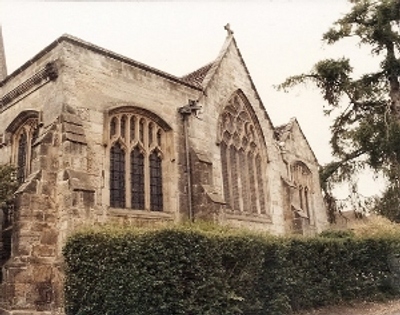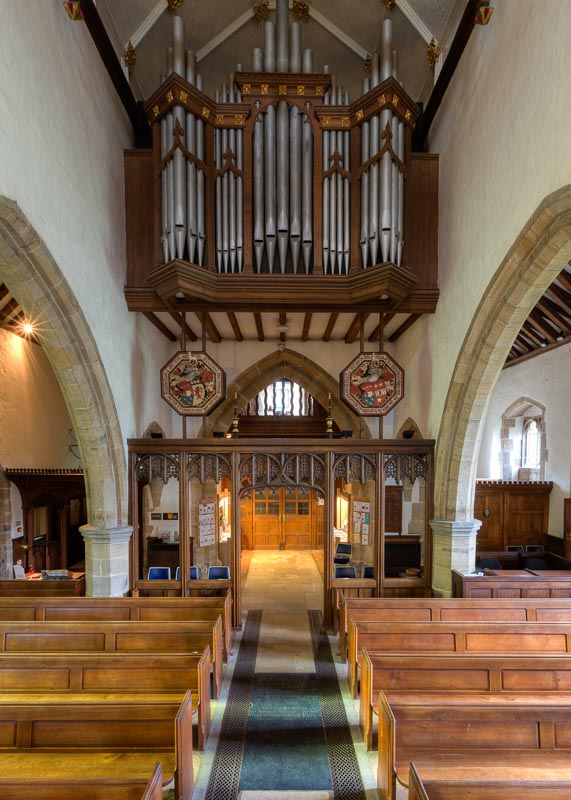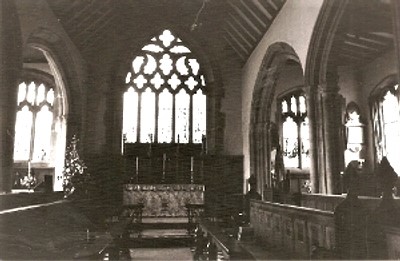Lindfield – All Saints
The church has developed from a cruciform one that was most probably C13 and much the same size as today, which was mostly rebuilt in the C14. Early C16 alterations included new chancel chapels and there was work in the early C17.
The parish of Lindfield belonged to the Archbishop of Canterbury’s peculiar of Malling Deanery (3 p57) and the canons were instrumental in procuring market rights for the village in the mid-C14. The church, for which a dedication to St John the Baptist is also on record, stands at the northern end of an attractive village street, which is now effectively part of Haywards Heath. it is close to Old Place, the much embellished but essentially C16 residence of C E Kempe. As a result of burials, the churchyard has risen, so a gully has been dug round the church walls.
The church was built on a cruciform plan which is usually dated to the C13, though an earlier date seems in some respects preferable. The lower courses of the walls, distinguished by their rubble masonry, and the bottom stage of the tower remain from this earlier phase. Given the size and thus importance of this church, it would be surprising if there had been none before the C13 and the main reason for assigning it to that period has been the single lancet and moulded doorway in the tower, the angle-buttresses of which also point to this date. However, the tower could have been a later addition and so could be the further blocked south lancet inside, with part of a string-course. On both sides of the tower are corbels for lower aisle roofs, showing that it already had flanking aisles when first built.
A further reason for doubting the C13 date for the outline of the church is that it was to be almost completely rebuilt in ashlar on the same foundations in the C14; that would be a century or less after it had been built. An ogee-headed west window and a tower arch of two continuous chamfered orders were inserted in the lower stage of the tower and a slightly recessed upper stage was added with quatrefoil openings and a shingled broach spire. The dark and relatively short nave has no clerestory. The tower projects into the church, causing the western bays of the three-bay arcades to be lower and narrower. They otherwise resemble the other ones, with octagonal piers and only a shallow groove between the two orders of the head. The eastern arches also serve as transept arches and there is a similar one across the east end of each aisle, the heads of which on the outer sides die into the walls without abaci, like the west responds of the arcades.
The aisle walls were rebuilt in the C14. The north one, largely hidden by a C19 vestry, has a trefoil-headed west lancet and two north windows. The south aisle is battlemented, but the windows are later, especially the west one. The C14 double-storeyed porch has ogee-headed side openings and an arch with two hollow-chamfered orders, which is considerably retooled, like the south doorway. The upper chamber, approached by a spiral stair, has an ogee-headed window and was at various times a strong room and a school.
The chancel is also C14, as the east window and the chancel arch show; the latter is like the other C14 arches. The five-light window is abnormally ambitious for Sussex, with flowing tracery centred on a cusped oval. This resembles other, mostly smaller, windows of the period in mid-Sussex. Though the chancel chapels are early C16, there are C14 arches from the transepts like the others, so there were C14 predecessors.
C15 work is limited to a three-light square-headed window in the south aisle, but more was done in the early C16, with the replacement of both chancel chapels. Their two-bay arcades are similar, with piers of four shafts and four hollows section and moulded four-centred heads. Probably dating from the same time is the stair to the roodloft from the south transept – the loft was not removed until 1583 (SAC 19 p40). The south chapel was built by the Massett family and in the late C18 the name of Thomas Massett was visible on the exterior (5 p23). Warden of the Skinner’s Company in 1491-92, he or his brother William (who left money for repairs in 1500 (4 p217)) is probably the builder, since one of the image-brackets above the altar in the form of angels bears the arms of the company. The chapel has depressed south windows and the east wall is at an angle. The east windows of both chapels have segmental heads and panelled tracery and the similarity of these, as with the arcades, suggest that the chapels were planned together. However, the north chapel has square-headed side-windows and a gabled roof with moulded tiebeams; the roof of the south chapel is almost flat behind a parapet. The south transept was altered at this time, though the C14 walling was probably kept. Its east window resembles those of the chapels and though different, the others are of the period. At the south west corner of the aisle is a blocked doorway with a depressed head with a small window over, of uncertain purpose.
Precise dates for work in the late C16 and C17 can be established and though not continuous, these suggest a steady campaign of work. The outer door of the porch stair is dated 1591, including the lock (5 p11), and the east gable is dated 1617, either side of a two-light square-headed window. The plastered nave roof and, judging by its appearance, that of the south chapel, were restored in 1602, the former with bosses and the latter with pendants. The alteration to the gable was probably a consequence. Also in 1602, the south wall was repaired and the Horsham slabs on the roof renewed (7 p43).
The church underwent an early restoration at the hands of a Tractarian vicar. The architect was J H Taylor (ICBS) and the dates 1845-49 are normally given. However, David Parsons (in his commentary to Sir Stephen Glynne’s description in SRS 101 p184) suggests that work did not get under way until 1848 and then took two years. Taylor rebuilt the north transept on the old foundations with details in late C13 style and probably replaced the roofs of the south transept and chancel, though a few timbers look older. Apart from these, the church today looks much as in the Sharpe Collection drawing (1805). M A Lower regretted the removal of most old fittings (II p30), but by 1869 the restoration was criticised as inadequate, notably the retained plastered nave roof, which it was then intended to strip (B 27 p631). However, nothing was done until 1883-84, when Somers Clarke junior and J T Micklethwaite undertook a second restoration (WSRO Ep II/27/190) at a cost of £2969 (KD 1899). They treated features like the nave roof with more respect, so the plaster survives. There was further work in 1931 by P M Johnston (2 p276) and in 1946-47 L K Hett refitted the south chapel (BE(W) p484).
In 2016-17 the church was re-ordered and many C19 fittings were either removed or altered, including a screen by Kempe (V 52 (July 2016) p25).
Fittings and Monuments
Aumbry: (South aisle) Probably C14 and found in 1931 (ibid).
Brass: (South east crossing pier) Stephen Borde (d1567) and his wife Pernell. The figures were missing in 1778 when seen by Sir William Burrell and the stone broken (6 pp57-58). It has been badly re-assembled, but much of the inscription remains. It was above the heads of the figures under a skull.
Font: C15 with an octagonal bowl and a square base, both arcaded.
Glass:
1. (East window) W Wailes, 1862 (B 20 p683).
2. (South chapel, second window) W Warrington and Co, 1888. Acts of Mercy (B 55 p254).
3. (South transept, south window) W Warrington and Co, 1889 (www.stainedglassrecords.org, retrieved on 11/3/2013).
4. (South aisle, west window) J Powell and Sons, designed by G Parlby, 1895 (Cash book)
5. (South chapel, third window) C Whall, c1906 (ibid). It shows Justice and Prudence.
6. (South transept, east window) Mayer and Co, 1906 (signed).
7. (North transept, east window) Kempe and Co, 1909, to commemorate the birth of W Tower‘s daughter.
8. (South porch, side windows) J Powell and Sons, designed by G Hutchinson 1910 (Hadley list).
9. (South chapel, east window) Kempe and Co, 1919.
10. (North chapel, east window) G Webb, 1935 (DSGW 1939).
Monuments:
1.(South aisle) William (d1790) and Harriot (d1809) Board. A draped urn above an inscription in two colours of marble by T and G Marshall (Roscoe p814).
2. (South aisle) Thomas Gibbs Crawfurd (d1830) Sarcophagus with low pediment, apparently signed by Martin of Lewes, though Llewellyn (p220) suggests this read originally ‘Martin and Parsons’.
Paintings: A wall painting, probably of St Margaret, on the east wall of the south transept was found during the first restoration (1 p129), but was not preserved. Also no longer extant is a Doom described by J L André without giving any date (1900 p302). This said to have included a figure of the Virgin bearing down on the scales held by St Michael.
Piscinae:
1. (South chapel and chancel) Simple and square-headed ones, dating from the early C16.
2. (North chapel) Early C16 moulded and pointed.
Pulpit: Oak, 1888 (Arch J 1 p325). This is likely to belong, like the reredos below, to the furnishings for which C E Kempe was responsible after the second restoration (V 47 (November 2014) p25).
Reredos: Oak, installed in 1895 (ibid).
Sources
1. Anon: Ancient Mural Painting, lately Discovered in Lindfield Church, SAC 2 (1849) pp129-31
2. M Cooper: Cuckfield Local Report, SAC 72 (1931) p276
3. E H W Dunkin: History of the Deanery of South Malling – VII Lindfield, SAC 26 (1895) pp57-59
4. W H Godfrey: All Saints, Lindfield, SNQ 5 (Aug 1935) pp217-18
5. H Hall: Guide to All Saints’ Church and the Village of Lindfield, (revised edition) 1968
6. : The Borde Brass in Lindfield Church, TMBS 56 (Dec 1935) pp57-64
7. M A Lower: On some Old Parochial Documents Relating to Lindfield, SAC 19 (1868) pp36-52
Plan
Measured plan by H Hall in 5 opp p1
Acknowledgements
1. My thanks to Josie Campbell for the colour photograph of the tower
2. My thanks also to Mike Anton for the photographs of the interior.






